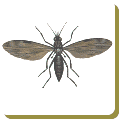 Midge — Midges are widely distributed in the United States and Canada. The most common midges people complain about are non-biting nuisance pests belonging to the family Chironomidae. The general public often refers to them as “gnats.”
Midge — Midges are widely distributed in the United States and Canada. The most common midges people complain about are non-biting nuisance pests belonging to the family Chironomidae. The general public often refers to them as “gnats.”
Chironomus midges are similar in appearance to the mosquito, but they cannot bite. Midges have plumose antennae that resemble a small feather. They are very small–none larger than 1/8-inch long. The adult midge may be a variety of colors from dark brown to green.
Midge populations are dependent on water–this includes a variety of sources including wet soil or plant waterings. In the Lincoln area, homeowners in the Capital Beach area are perennially faced with large numbers of midges during periods of the warmer months. Typically, male midges swarm in large numbers at dusk. Mating occurs when females enter the swarm.
Like mosquitoes, the midge larval stage is aquatic. The adult females lay eggs in masses over open water or attached to aquatic vegetation. They hatch in several days and the young larvae drop to the bottom where they build tubelike structures of bottom debris held together by strands of silk. One interesting fact is that the blood of some midge larvae (called bloodworms) is red, unlike the blood of most other insects. It is red because it contains hemoglobin which binds tightly to oxygen. This is necessary because of the stagnant, low oxygen conditions that may be present where these larvae live.
The larvae are scavengers, feeding on bottom debris. Under favorable conditions, they are larvae for about four weeks and then they pupate for several days. Just before emergence, the pupa rises to the water surface, emerging from the water surface, like a mosquito. Larval midges are very beneficial because they serve as food for fish.
During their swarming activities, adults may be attracted to lights. Buildings with outside lighting will attract large numbers of these insects. If these lights are around vent openings, air conditioning units or windows, the insects can find ways into the structure. The next day, dead midges can be found on window sills, possibly through the entire building. This causes concern to homeowners and occupants of office buildings, hotels and healthcare facilities.
Avoid the use of unnecessary lights around dusk when midges swarm. If midges are entering the house, make sure that vent openings and other entry points are sealed.
Pools of standing water should be drained if possible; yet, it is not possible to prevent midges from breeding in lakes and permanent bodies of water.
Area insecticide fogs applies to foliage will provide some temporary control of adults.
 Kids Portal For Parents India Kids Network
Kids Portal For Parents India Kids Network
